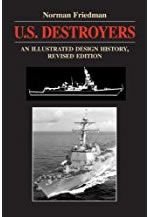USS Patterson (DD-36)
fitting out, 1911
|
|
USS Patterson (DD-36) was a Monaghan class destroyer that took part in the US intervention in Mexico in 1914, was based at Queenstown for almost a year from June 1917, then operated with a hunter-killer antisubmarine group off the US east coast. After the was she spent several years operating with the US Coast Guard.
The Patterson was named after Daniel Todd Patterson, a US naval officer during the Quasi-War with France, the conflict with Tripoli and during the War of 1812. She was laid down on 29 March 1910, launched on 29 April 1911 and commissioned on 11 October 1911. The Patterson was the most economical of the 'Flivvers', with a range at cruising speed of 3,919nm and at 20kts of 2,668nm. This compared to USS Perkins, which could manage 2,424nm and 1,470 respectively.
The Patterson was based at Boston, and spent most of the pre-war period on the normal mix of winter operations in Cuban waters and summer operations off the US East Coast. She took part in the US intervention in Mexico in 1914, and spent the period between 20-24 May at Veracruz. Anyone who served on her between 22 April and 26 May 1914 qualified for the Mexican Service Medal.
In the first few weeks after the US entry into the First World War the Patterson was used to patrol the approaches to Newport and Boston. She was then assigned to the second destroyer division to be sent to Europe, Division 5, as the flagship. The squadron left Boston on 21 May 1917, and on 28 May, in the mid Atlantic, met up with the oiler Maumee (amongst her crew was the young Chester W. Nimitz). The Patterson was the first of the destroyers to refuel from the Maumee, allowing her to make the entire crossing under her own power (some other destroyers had to be towed for part of the trip). The division then continued on to Queenstown, Ireland, arriving on 1 June 1917.
On 5 June the Patterson began a series of patrol and escort missions that lasted into June 1918. During that period she had a number of encounters with U-boats.
On 12 June 1917 she dropped depth charges to prevent a U-boat attack on the SS Indian.
On 1 January 1918 she collided with the tug Dreadful at Berehaven Harbour, suffering damage to her bow that kept her out of action until 5 February.
On 7 February she rescued 12 survivors from the SS Mexico City, sunk by a U-boat.
On 17 May she carried out a depth charge attack that drove away U-101.
On 19 May the Patterson (DD-36) sent a message to the Allen (DD-66) asking for help in hunting down a possible damaged U-boat west of Bardsey off the tip of the Lleyn Peninsula. This call attacked a sizable force of six destroyers, including two British ship, the Burrows (DD-29) and the Beale (DD-40). The combined flotilla dropped depth charges at about 20.30, and bubbles of oil came to the surface, but there was no other evidence of damage to a submarine.
Her last patrol from Queenstown ended on 4 June 1918. She then set out for the US. On 16 June, near Bermuda on the voyage home she rescued survivors from the Norwegian ship Kringsjaa, sunk by U-151.
After an overhaul that lasted into August the Patterson became the leader of the Patterson Group, a hunter-killer antisubmarine group that also included 11 sub chasers. The group operated between the Virginia Capes and New York.
On 27 August she rescued survivors from the sub chaser SC-188, sunk by friendly fire from the merchant ship Felix Taussig, whose crew had mistaken the SC-188 for a submarine.
On 3 September she dropped depth charges to drive away a possible U-boat.
Anyone who served on her between 1 June 1917 and 10 November 1918 qualified for the First World War Victory Medal.
The group disbanded on 23 November 1918, after the last threat from lingering U-boats was over. She entered the Philadelphia Navy Yard on 1 January 1919, and remained out of service until she was allocated to the Coast Guard on 28 April 1924 to take part in the 'Rum Patrol'. This lasted until 18 October 1930 when she was returned to the Navy and decommissioned once again. She lost her name on 1 July 1933 to allow it to be reused on the Bagley class destroyer USS Patterson (DD-392). She was sold for scrap on 2 May 1934.
Displacement (standard) |
787t |
Displacement (loaded) |
883t |
Top Speed |
29.5kt design |
Engine |
3-shaft Parsons turbines |
Range |
2,175nm at 15kts on trial |
Length |
292ft 8in |
Width |
27ft |
Armaments |
Five 3in/50 guns |
Crew complement |
89 |
Launched |
29 April 1911 |
Commissioned |
11 October 1911 |
Fate |
Sold for scrap 1934 |
 U.S. Destroyers: An Illustrated Design History, Norman Friedmann .
The standard history of the development of American destroyers, from the earliest torpedo boat destroyers to the post-war fleet, and covering the massive classes of destroyers built for both World Wars. Gives the reader a good understanding of the debates that surrounded each class of destroyer and led to their individual features.
U.S. Destroyers: An Illustrated Design History, Norman Friedmann .
The standard history of the development of American destroyers, from the earliest torpedo boat destroyers to the post-war fleet, and covering the massive classes of destroyers built for both World Wars. Gives the reader a good understanding of the debates that surrounded each class of destroyer and led to their individual features.